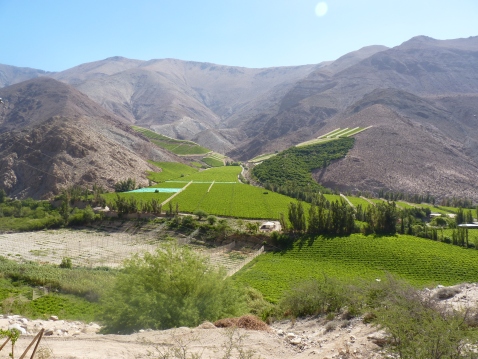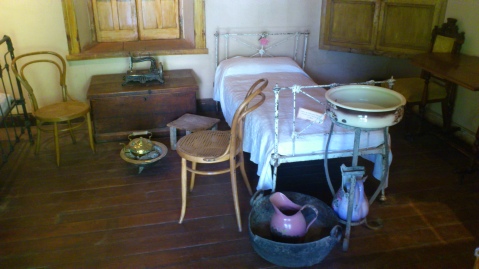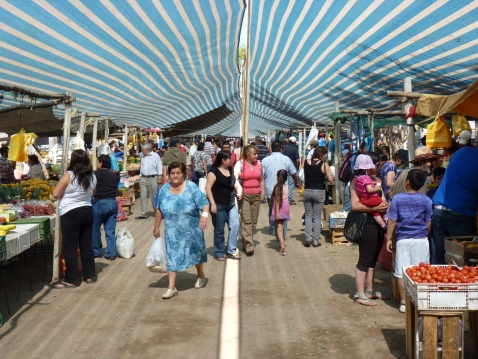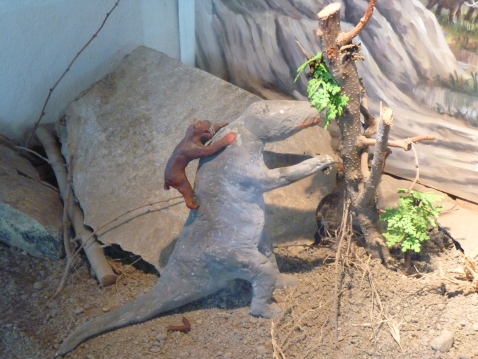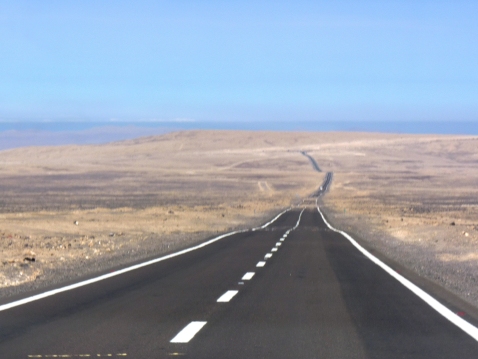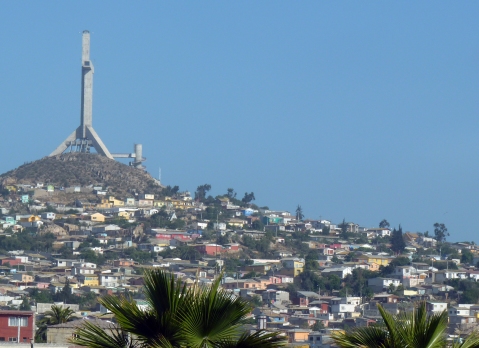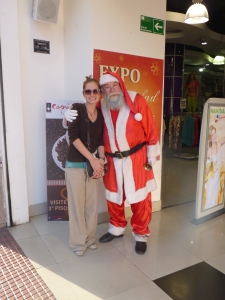El Grande Norte 2: Elqui to the Atacama
I can see why the hippies liked the Elqui Valley. An oasis in the desert fed by the Elqui river, this lush valley is surrounded by arid mountain tops silhouetted by famously crystal clear skies. There is definitely an ‘onda’, or vibe to the place. It’s zen. According to the alternative lifestyle seekers who flocked here in the 1960s, it’s actually the centre of the Earth’s magnetism, which shifted from the South Pole to roughly this spot in Chile. While I did feel drawn down the valley, I think this was more because of the aesthetics of the place, rather than its magnetic field. With Gerald at the wheel of our white Nissan Tiida, and his four passengers in tow, we headed upstream to see what all the fuss was about.
The contrast between green vineyards and the rocks beyond is the first thing that hits you, and it is stunning. You can see how the place must have inspired the Chilean poet Gabriella Mistral, who was born here in 1889 in the town of Vicuña, at the opening of the valley, but grew up further upstream in the small village of Montegrande. There is a small museum and statue in this tiny village dedicated to poet, educator and feminist who is still the only Latin American women to have won the Nobel Prize for literature. You get a chance to peer into the original bedroom of the young Gabriella (born Lucila Godoy Alcayaga), read original letters and samples of poetry. Sadly my Castellano is not of a high enough standard to appreciate the literature, so a return visit might be necessary. A few signs of the alternative folk who made a life here is still evident, like the dreadlocked couples selling Mapuche symbols carved from gourd skin. Generally they must be tucked away further up the valley. Most of the people we encountered were tourists, Chilean and Gringo, more interested in Mistral than magnetism.
Heading back out of the valley you reach Vicuña (not to be mistaken for one of these guys), a more lively town with a busy market and large Plaza de Armas (try and find a town in Chile without one). If you have time you can arrange a visit to an observatory for a few thousand pesos, with transport provided and see the stunning night sky through a scope. With little time we had to remain Earth bound, visiting instead a fascinating, albeit dusty entomology and natural history museum on the south side of the plaza. This had an impressive collection of semi-precious stones and seashells from around the world and some inspiring displays:
As you travel north away from the Elqui Valley you start to enter the Atacama proper. This is where the north of Chile starts getting weird. The Pan-American highway, the artery through which almost all of Chile’s goods, people, food and beer flow, runs like a line of hot treacle across this arid expanse. The scale alone impresses. Tiny specs in the distance take 15 minutes to reach you, becoming vast trucks loaded with anything from sulphuric acid for the copper mines, to beer, for…well, probably the copper mines… and everyone else who lives in this barren place. Beer does seem to be the lifeblood of this part of Chile. Almost every other truck is a Crystal truck.
Yes, the Crystal highway ensures that even on the driest place on earth, beer is within easy reach. Having spent two weeks in this place, you can understand the urge to drink. It’s barren. Sure, the landscapes are stunning. Beginning with undulating red and golden hills you slowly creep upwards and northwards onto vast flat plains with the white foothills of the Andes shimmering in the distance. But there is nothing here. A rock stands out as a point of interest. Something to go and look at! The road itself is the most interesting thing to marvel at. The way it crawls on, unforgiving, through plain, mountain and valley with nothing to support it but itself. How they ever built this thing out here is beyond comprehension.
A few hundred miles north of La Serena the road takes a rare turn and heads for the coast. Just as you become accustomed to the bareness of the desert, as the road winds down valleys towards the pacific you are hit with a dose of something unexpected. Bleakness. Yellow sun, white desert and golden hills I can handle. Grey skies, grey rock, grey sea, I cannot. The coast from here to Iquique is blanketed by an almost permanent layer of thick, low cloud, washing out the colour palate of the desert and creating a land of monotone. It was here, during a night in the small town of Taltal, that food poising took us by surprise and the journey north seemed its bleakest yet…
El Grande Norte 1: Santiago to La Serena
I was hanging out of the rear window of our hire car. The desert stretched out in every direction as far as the eye could see, the volcanic Andes to our east, the slowly descending plains to our west. With my torso out of the window, I could angle myself to examine the deflated rear tyre we were now driving on. Every few seconds I was shouting to Gerald, our driver, that it was still holding on… just. After about 5 km of this, speeding along a dirt track through the Chilean Altiplano, 100 miles from anywhere, I watched the tyre slip off and roll to the distance, settling next to a large rock. Shouting at Gerald, we ground to a halt, the car resting on its steel wheel rim. We watched the sun start to lower in the sky towards the volcanic horizon. It was our spare tyre. We had no replacement. Perhaps this road trip around the north of Chile wasn’t such a good idea.
Chile is long. It is so long, that if you tore it up from the crust of the Earth and laid it over Europe, despite causing immense destruction, it would reach from London to Baghdad. Gerald, a friend of my girlfriend’s father who was visiting from France, decided he wanted to drive through the northern half of it. In a Nissan Tiida. This is a family saloon car designed for day trips on paved roads and inter-city hops, not a 2000 mile road trip through one of the most inhospitable landscapes on Earth. Despite this, Gerald, along with his wife, my girlfriend, her father and I, decided this sounded like a good trip. Having just arrived in Chile my girlfriend and I had no immediate plans. A chance to be driven around the Atacama desert, the driest place on Earth, was an opportunity not to be missed. The trip would take us 1000 miles north from Santiago, stopping at various towns and cities on the coast along the way, to Arica, a city just south of the border with Peru. We would then return south along a more winding route further inland, through the high plains or Chilean Altiplano. The transition in landscape is subtle and slow but the eventual difference between places extreme.
We set off from central Santiago and after a gruelling two hours of dense traffic we eventually escape onto the Pan American Highway, the paved artery that connects Chilean Patagonia with Alaska, if you drive far enough. Heading north through the low rise hinterlands and the industrial areas the city slowly gives way to the Mediterranean-like scrubby low land. After a few hours driving we reach La Serena. This coastal city is a tourism hub for Chileans, a summer escape for the people of Santiago to the cooler sea air and sandy beach. Opting to avoid the city itself for somewhere to stay, we find a cabaña near Coquimbo, a densely packed peninsular just south of La Serena that overlooks the city and its wide bay. Coquimbo is a less friendly tourist spot than La Serena itself, but worth visiting. It’s a quiet place with tightly packed streets and colourful ramshackle old houses. They wind around a steep hill, leading towards an immense concrete building in the form of cross. This monument to the Christian faith, one of the largest in South America, was opened in 2000, representing the Third Millennium of Christ. You literally can’t miss it, which is unfortunate, as it’s horrendously ugly. I’m not a man of faith though. Believers may take a different view.
The next day we ventured into La Serena. The city has a pleasant Plaza de Armas, or central square, surrounded by Spanish colonial buildings. Its tiled pavements and streets lead off into busy shopping districts, with the usual mix of department stores, clothes shops, pharmacies and artisanal markets. Being just a few weeks before Navidad (Christmas) it was packed, and we even got a chance to meet Father Christmas. The real attraction of La Serena is its huge beach which gently curves north for 10 miles. Unfortunately, this being the Pacific there is the ever present Humboldt current carrying ice cold water from the Antarctic Ocean north along the coast of Chile. This doesn’t put off reams of Chilean visitors, who after a dip in the ocean treat themselves to tasty sweet snacks like tortas, dulces de la ligua and helados, all sold by men who walk the length of the beach carrying their goods on huge trays or in polystyrene boxes.
Inland from La Serana, there are beautiful valleys tucked away across this region, hiding incredible oases. These microclimates are used to grow the Pisco grape, the infamous national liquor of Chile. The Elqui Valley, birthplace of Nobel prize winning author Gabrielle Mistral, is one of the most spectacular. Dense green cultivated patches of land hug tightly to the river in the bottom half of the valley, the farmers irrigating the land as far uphill as gravity will allow. The green then suddenly gives way to barren white and yellow rock, bare mountain tops leading to the desert beyond…
Next post: Mistral and Markets in the Elqui Valley, the Pan American (or Crystal Highway) and food poisoning along the bleakest coast on Earth.
